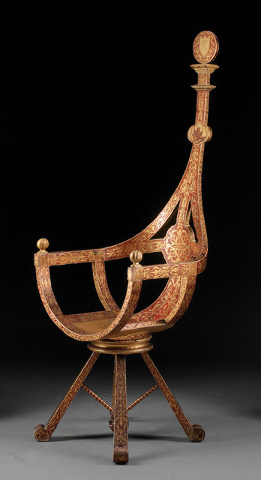Rare Venetian chair resembles gondola seat
A gondola chair, according to furniture dictionaries, is a late 18th- to early 19th-century chair with a concave back and side rails that curve down to the seat. It has four legs and is upholstered on the seat and on both the front and back of the chair back and the arms. It is a chair type that still is being made.
But there is another more glamorous “gondola chair” that is less-publicized. The antique Venetian gondola chair is carved and painted or upholstered in leather. It has a high back that curves down to the seat. The sides of the back continue forward to form arms that are attached to the seat by another curved support. It has four splayed legs that start at the seat and slant away from the chair.
This type of chair was made in the 1800s and got its name from its shape. The chair looks a little like the front of an Italian gondola. It may even have been a seat for a gondola passenger.
The Venetian gondola chair is rare and even the leather-covered ones are expensive. But a carved and painted example sells for thousands of dollars. Neal Auction in New Orleans sold one in 2014 for $1,917.
Q: When I married in 1972, my mother gave me my grandmother’s dishes. There are 10 plates and one large serving plate. The large plate has a hand-painted rabbit on it. Two of the dinner plates are painted with rabbits, two with deer, two with gazelles, and two with cows. The backs of the plates are marked “LS &S, Limoges, France.” Are they worth anything?
A: This mark was used by Lazarus Straus &Sons, an importer and manufacturer in the United States. Lazarus Straus was born in Germany, immigrated to the United States in 1852, and began working as a pushcart peddler in Georgia. He opened a dry goods store there two years later.
In 1869, he founded L. Straus &Sons in New York City. The company sold its china and glassware in Macy’s department store basement beginning in 1873. Members of the Straus family became part owners of Macy’s in 1884 and sole owners in 1896.
You have most of a set of game plates made in Limoges, France, and imported by L. Straus &Sons. These usually came with 12 plates plus a larger serving platter and were popular during the 1880s. Sets of game plates sell for about $375.
Q: I have a Dobro guitar that I got in 1956 when I was 10 years old. I think it’s a Rex Ampliphonic guitar or Dobro. I don’t know much about this guitar but some Dobro players have told me it’s definitely an antique.
A: Ampliphonic guitars, also known as self-amplifying or resonator guitars, were developed about 1927 by John Dopyera. He and his brothers founded Dobro Manufacturing Co. in 1928.
In 1929, he was granted a patent for his design for a guitar with a thin metal body and three aluminum diaphrams (resonators) to amplify the sound. Dobro guitars sold under several brand names in the 1930s. The Gibson Guitar Corp. has had sole rights to the Dobra name since 1993.
Good quality old guitars sell for high prices. Find an expert at a shop that sells guitars or an auction house to find out what your guitar is worth.
Q: I have a Western-style working saddle made in the late 1890s or early 1900s by the Nebraska Saddlery Co. of Fremont, Neb. The company no longer exists. The design on the leather was done by hand and the stirrups have the original copper encasement around the bottom. The cinch, tie straps, stirrup hobbles and sheepskin under the saddle are new.
I’d like to sell it to someone who appreciates such a beautiful piece of work and can just throw this on a horse and go to work. Where can I find someone who can give me an honest appraisal?
A: A vintage saddle like yours might sell well at an auction that specializes in Western items. You should be able to get an idea of value from a store that sells new quality leather saddles. Most major cities have stores that sell equestrian equipment.
Auction houses that sell Western-style items can be found by an online search. Most are located in the western U.S., but have online sales and interested bidders.
Q: I’m interested in selling a Pachinko game machine, a four-reel nickel slot machine made by Wisconsin Novelty, and a Michigan Model 7 candy store cash register. I’ve searched online but haven’t been able to find any information or an estimated value for them. What’s the best way to sell them?
A: All of your items can be sold at an auction or antiques shop. You can check prices on our website, Kovels.com, or on auction websites. Look at a site like Liveauctioneers.com to see which auction houses have sold similar items and contact them to see if they are interested in what you have. Some won’t take items below a certain value. Lower priced items can be sold to a dealer or antiques shop.
Tip: A glass flower frog, a holder for the flower stems in an arrangement, can be useful. Look for the round glass holders with many holes. Each hole can hold a marble so a group of about five to 15 stems can be displayed in different sizes of flower frogs.
Terry &Kim Kovel’s column is syndicated by King Features. Write to: Kovels, (Las Vegas Review-Journal), King Features Syndicate, 300 W. 57th St., New York, NY 10019.




























